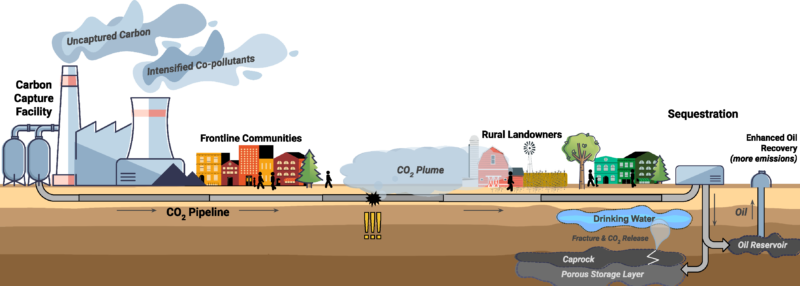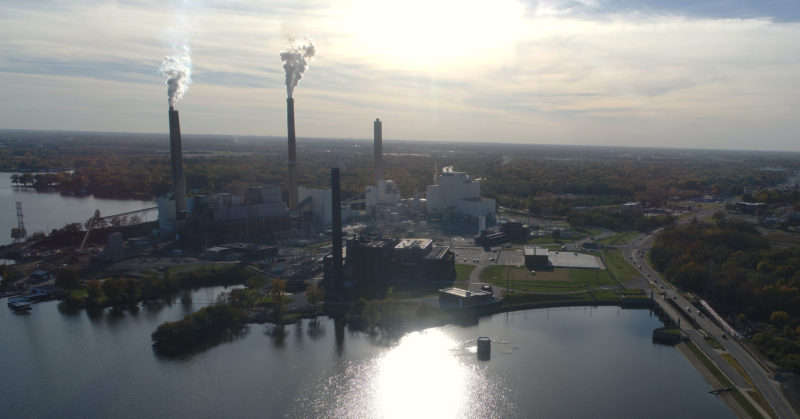Due to our state’s unique geology and an influx of federal incentives, Illinois could become ground-zero when it comes to carbon capture and storage (CCS), and the State is unprepared to protect us from this growing threat. Fossil fuel and ethanol companies are looking to exploit gaps in Illinois’ regulatory framework, putting Illinois landowners, public health, water resources, and our climate at risk.
What is CCS?
Carbon capture and storage is the process of isolating CO₂ either at a source (power plant, factory) or directly from the air. Then the captured CO₂ is transported, often through a pipeline, and stored, usually in underground geological formations such as saline reservoirs or depleted oil reservoirs. Carbon capture technology may one day be used to help decarbonize the “hard to decarbonize” industries such as steel and cement. However, in the short term, it is likely to be used to extend the life of coal and gas power plants as well as ethanol plants, hurting our chances of advancing Illinois toward its climate goals.

What is at Stake?
There are major concerns with CCS at every step in the process. Here, we will break down a few of them.
Operation of carbon capture equipment is likely to increase pollution for frontline communities. Running carbon capture equipment requires a significant amount of energy – called a parasitic load. Power plants will have to operate more to generate the energy necessary to capture the carbon they are producing. Worse, the financial incentives for carbon capture may drive an economic decision to run dirty power plants more. That additional operation leads to increases in all of the non-CO₂ pollutants that power plants produce, including smog-creating and health-harming airborne pollutants, and for coal fired power plants, more coal ash.
Leaking or failed CO₂ pipelines and sequestration sites undo any climate benefit of capturing CO₂ – and can even be life-threatening. The failure of a compressed carbon pipeline in Satartia MI gave the US its first real insight into what a pipeline rupture could look like. A CO₂ pipeline belonging to Denbury Enterprise ruptured and released a plume of CO₂ into Satartia. Residents were sickened and disoriented by the plume. Cars and emergency vehicles, relying on engines that combust oxygen, shut off. First responders were unequipped for the situation and walking into the unknown. That no one was killed is simply good luck.
The climate benefit of carbon capture is not guaranteed, and use of this technology could even result in more CO₂ being released. Some studies show that the use of carbon capture may actually increase net emissions, turning CO₂ into a commodity worth producing. Furthermore, captured carbon is often used for Enhanced Oil Recovery (EOR) (90% of captured carbon in 2021), that is, using captured carbon to extract more oil and gas out of the ground. Studies show that using CC for EOR could lead to 4 times as much CO₂ being released as it removes.
Lastly, sequestering CO₂ underground poses risks to our water. A leaky storage layer may cause CO₂ to rise into drinking water aquifers and alter the water chemistry. This could mobilize inorganic compounds (such as heavy metals) into the drinking water. The storage CO₂ can also mobilize organic compounds (such as Benzene) which could travel with the CO₂ leak into drinking water. These threats are not well understood, but the burden should fall on industry to prove that our water will be safe, particularly sole source aquifers like the Mahomet Aquifer.

Big Carbon is Coming…
Industry is moving carbon capture forward in Illinois on multiple fronts. Two of Illinois’ remaining coal fired power plants – Prairie State and Springfield’s Dallman – are seeking to install carbon capture systems as a way to keep operating until 2045 (unfortunately CEJA did not forbid this). Dallman has installed a pilot carbon capture system, and Prairie State is exploring options. ADM, already engaged in sequestration in Decatur, is working with Wolf Carbon Solutions to expand its operation and bring in more CO₂ from ethanol plants in Iowa with a proposed pipeline cutting across part of Illinois. Among the many proposed connections, that pipeline will connect to an ethanol plant on the Southside of Peoria; a community already facing high pollution and socioeconomic burdens. The Navigator Pipeline is proposed to be 1,300 miles long and carry carbon captured from ethanol and fertilizer production from four states across 13 Illinois counties. Carbon capture is here and looking to grow in Illinois’ unregulated landscape.
Meanwhile, carbon industry giants are pushing state legislation to protect their business interests in CCS at the expense of Illinois taxpayers. Their legislation would allow companies to amalgamate a property owner’s land for sequestration (like eminent domain), pass liability of stored CO₂ to the state, and lacks any assessment of environmental risks or opportunities for public participation.
…Unless You Take Action
It is clear that Illinois needs to take action to protect itself from a goldrush of industry interest in CCS. The Carbon Dioxide Transport and Storage Protections Act, HB3119, would protect Illinois communities, shield the state from absorbing industry’s risk, ensure environmental assessment at every step of the CCS process, and include meaningful public participation. PRN is working with environmental partners in the state to support HB3119 and protect Illinois’ communities and our state’s commitment to climate action, instead of industry’s bottom line.







